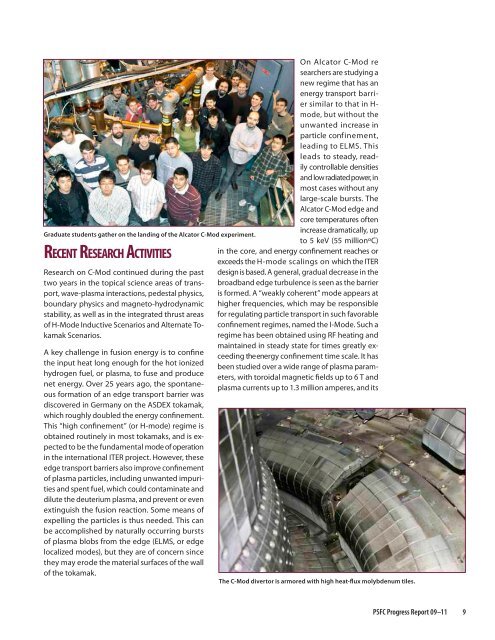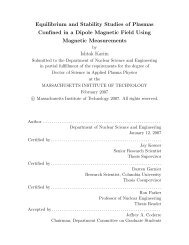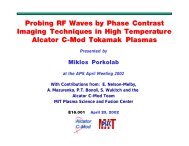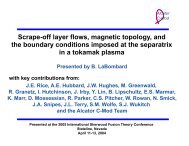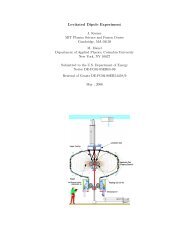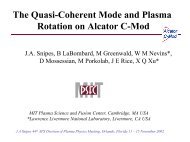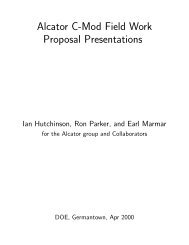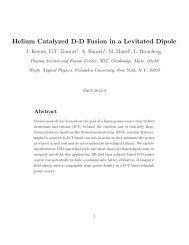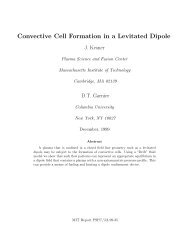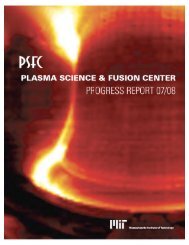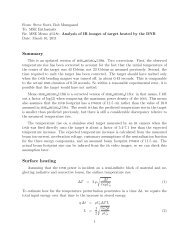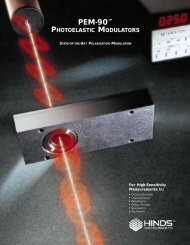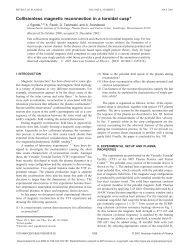Download a copy of the latest PSFC Progress Report - Plasma ...
Download a copy of the latest PSFC Progress Report - Plasma ...
Download a copy of the latest PSFC Progress Report - Plasma ...
Create successful ePaper yourself
Turn your PDF publications into a flip-book with our unique Google optimized e-Paper software.
Graduate students ga<strong>the</strong>r on <strong>the</strong> landing <strong>of</strong> <strong>the</strong> Alcator C-Mod experiment.<br />
Recent Research Activities<br />
Research on C-Mod continued during <strong>the</strong> past<br />
two years in <strong>the</strong> topical science areas <strong>of</strong> transport,<br />
wave-plasma interactions, pedestal physics,<br />
boundary physics and magneto-hydrodynamic<br />
stability, as well as in <strong>the</strong> integrated thrust areas<br />
<strong>of</strong> H-Mode Inductive Scenarios and Alternate Tokamak<br />
Scenarios.<br />
A key challenge in fusion energy is to confine<br />
<strong>the</strong> input heat long enough for <strong>the</strong> hot ionized<br />
hydrogen fuel, or plasma, to fuse and produce<br />
net energy. Over 25 years ago, <strong>the</strong> spontaneous<br />
formation <strong>of</strong> an edge transport barrier was<br />
discovered in Germany on <strong>the</strong> ASDEX tokamak,<br />
which roughly doubled <strong>the</strong> energy confinement.<br />
This “high confinement” (or H-mode) regime is<br />
obtained routinely in most tokamaks, and is expected<br />
to be <strong>the</strong> fundamental mode <strong>of</strong> operation<br />
in <strong>the</strong> international ITER project. However, <strong>the</strong>se<br />
edge transport barriers also improve confinement<br />
<strong>of</strong> plasma particles, including unwanted impurities<br />
and spent fuel, which could contaminate and<br />
dilute <strong>the</strong> deuterium plasma, and prevent or even<br />
extinguish <strong>the</strong> fusion reaction. Some means <strong>of</strong><br />
expelling <strong>the</strong> particles is thus needed. This can<br />
be accomplished by naturally occurring bursts<br />
<strong>of</strong> plasma blobs from <strong>the</strong> edge (ELMS, or edge<br />
localized modes), but <strong>the</strong>y are <strong>of</strong> concern since<br />
<strong>the</strong>y may erode <strong>the</strong> material surfaces <strong>of</strong> <strong>the</strong> wall<br />
<strong>of</strong> <strong>the</strong> tokamak.<br />
On Alcator C-Mod re<br />
searchers are studying a<br />
new regime that has an<br />
energy transport barrier<br />
similar to that in H-<br />
mode, but without <strong>the</strong><br />
unwanted increase in<br />
particle confinement,<br />
leading to ELMS. This<br />
leads to steady, readily<br />
controllable densities<br />
and low radiated power, in<br />
most cases without any<br />
large-scale bursts. The<br />
Alcator C-Mod edge and<br />
core temperatures <strong>of</strong>ten<br />
increase dramatically, up<br />
to 5 keV (55 millionºC)<br />
in <strong>the</strong> core, and energy confinement reaches or<br />
exceeds <strong>the</strong> H-mode scalings on which <strong>the</strong> ITER<br />
design is based. A general, gradual decrease in <strong>the</strong><br />
broadband edge turbulence is seen as <strong>the</strong> barrier<br />
is formed. A “weakly coherent” mode appears at<br />
higher frequencies, which may be responsible<br />
for regulating particle transport in such favorable<br />
confinement regimes, named <strong>the</strong> I-Mode. Such a<br />
regime has been obtained using RF heating and<br />
maintained in steady state for times greatly exceeding<br />
<strong>the</strong> energy confinement time scale. It has<br />
been studied over a wide range <strong>of</strong> plasma parameters,<br />
with toroidal magnetic fields up to 6 T and<br />
plasma currents up to 1.3 million amperes, and its<br />
The C-Mod divertor is armored with high heat-flux molybdenum tiles.<br />
<strong>PSFC</strong> <strong>Progress</strong> <strong>Report</strong> 09–11 9


